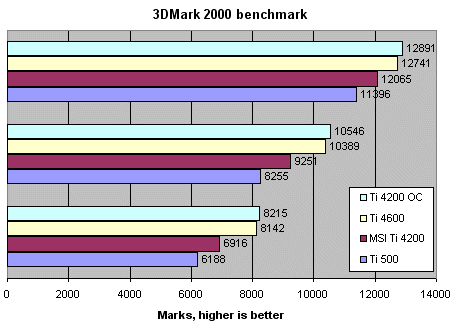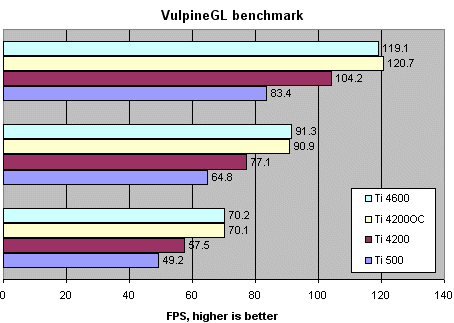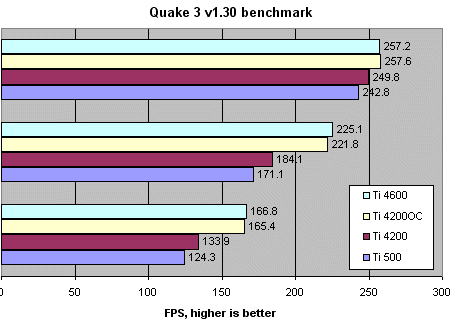Benchmarks I
|
Let's investigate performance under 3DMark 2000. We'll be conducting tests at 1024x768x32, 1280x768x32, and 1600x1200x32 respectively. This should give you an idea of how the MSI Ti 4200 handles DX7-compliant benchmarks. The relative lack of complexity should keep it close to the Ti 4600.
At standard clock-speeds (well, slightly inflated by MSI), the Ti 4200 is firmly sandwiched between the Geforce3 Ti 500 and Geforce4 Ti 4600, exactly as one would expect. Due to the prodigious overclocking of our test card, 320/608 MHz respectively on core and memory, it is able to just oust a standard Ti 4600. How about 3DMark 2001SE ?
More of the same here. The difference between the standard MSI Ti 4200 and the Geforce3 Ti 500 is more pronounced in this more graphically challenging benchmark. We can attribute the Ti 4200's enhanced lead to the dual vertex shading ability present, one that pays huge dividends in the dragothic benchmark in particular. Once again, we see the overclocked MSI Ti 4200 just ousts the standard Ti 4600. Its lack of memory bandwidth is just about offset by the extra 20MHz core speed. So far, the extra 64MB of on-board RAM for the Ti 4600 is making no noticeable difference. Let's see if this is still the case as we turn our attention our attention to the lovely Vulpine GL benchmark.
It appears not. Understandably, the MSI Ti 4200 is slower than a stock Ti 4600. We only get 104fps at 1024x768x32 as opposed to 119fps with the Ti 4600. The gap naturally widens as the test becomes more card limited. Still, the Ti 4200 comfortably outperforms the Geforce3 Ti 500 at every resolution. The overclocked Ti 4200, at 320/608, keeps parity with an unclocked Ti 4600. The 64MB of RAM is faring well against the 128MB of the Ti 4600. Now some Quake 3 action.
Again, the MSI Ti 4200 outpaces the Geforce3 Ti 500 at every resolution and manages to gain parity with its bigger brother once overclocked, it's looking like some budget card at the moment. Now we'll investigate its performance in a little more detail with anti-aliasing and anisotropic analysis. |













